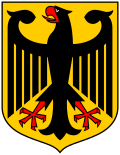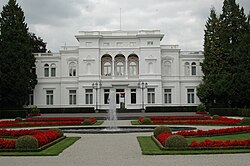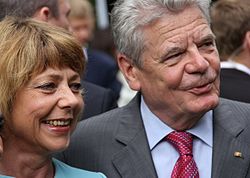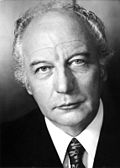President of Germany
(Redirected from President of Germany (1919–1945))
The President of Germany (German: Bundespräsident, literally: federal president) is the head of state of the Federal Republic of Germany. His functions are mostly supervising and representative, because of the negative experiences with the office of its predecessor the Reich President (Reichskanzler), who had more power than the current Federal President. The president is elected every five years by the Bundesversammlung.
| Federal President of the Federal Republic of Germany
Bundespräsident der Bundesrepublik Deutschland | |
|---|---|
Logo | |
 | |
| Style | Mr. President (informal) The Honourable (formal) His Excellency (diplomatic) |
| Residence | Schloss Bellevue (Berlin) Villa Hammerschmidt (Bonn) |
| Appointer | Federal Convention |
| Term length | Five years Renewable once, consecutively |
| Constituting instrument | Basic Law for the Federal Republic of Germany |
| Precursor | The Reichspräsident |
| Formation | 24 May 1949 |
| First holder | Theodor Heuss |
| Website | www |
 |
|---|
| This article is part of a series on the politics and government of Germany |
|
| Foreign relations |
The president is elected every five years by the Bundesversammlung.
List of presidents
- Theodor Heuss (FDP), 1949 – 1959
- Heinrich Lübke (CDU), 1959 – 1969
- Gustav Heinemann (SPD), 1969 – 1974
- Walter Scheel (FDP), 1974 – 1979
- Karl Carstens (CDU), 1979 – 1984
- Richard von Weizsäcker (CDU), 1984 – 1994
- Roman Herzog (CDU), 1994 – 1999
- Johannes Rau (SPD), 1999 – 2004
- Horst Köhler (CDU), 2004 – 2010
- Christian Wulff (CDU), 2010 – 2012
- Joachim Gauck (Independent), 2012 – 2017
- Frank-Walter Steinmeier (SPD), since 2017
President Of Germany Media
Bellevue Palace, Berlin (primary seat)
Hammerschmidt Villa, Bonn (secondary seat)
Former President Joachim Gauck and his partner Daniela Schadt
Anke Rehlinger, the current President of the Bundesrat and Deputy of the President of Germany










